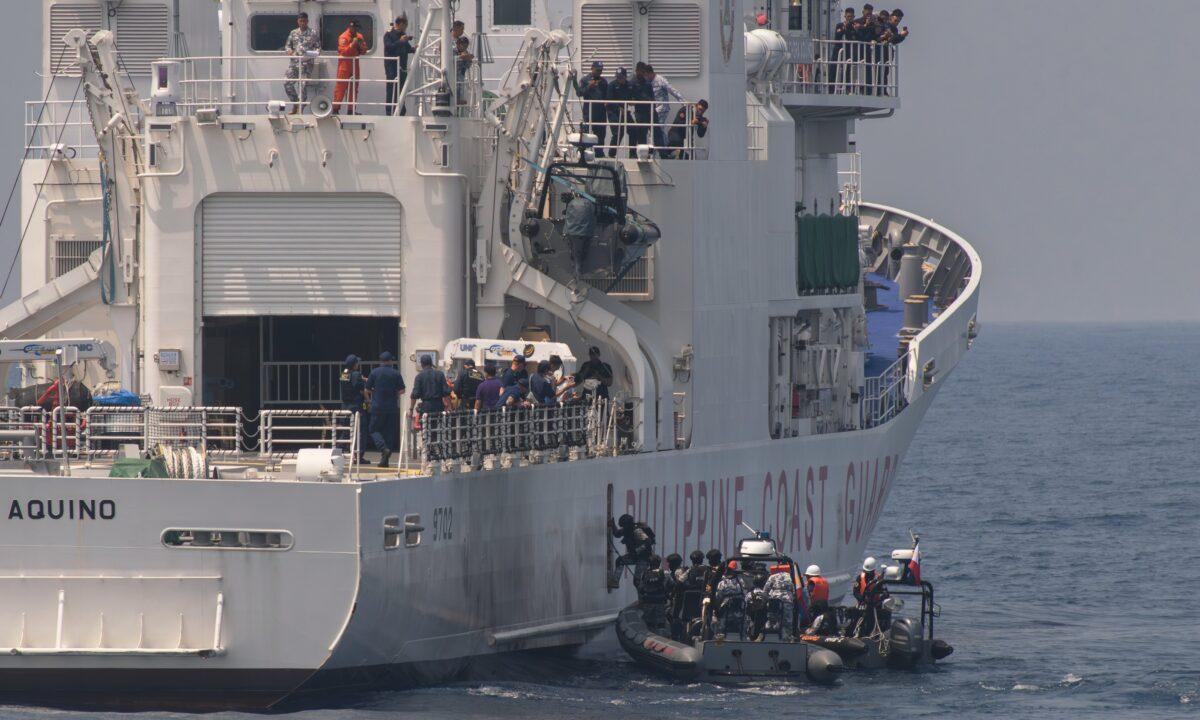The proposed United States’ $886.3 billion Fiscal Year 2024 defense budget features a $9.1 billion program designed to beef up allied operational efficiencies and fortify installations to counter aggression in the Western Pacific by China’s growing military.
Both Senate and House armed services committees last week adopted the Pacific Deterrence Initiative (PDI) within their Fiscal Year 2024 National Defense Authorization Acts (FY24 NDAA), or proposed annual defense budgets, which are set to be debated through summer and passed this fall. The $9.5 billion is a 40-percent increase from this year’s PDI allocation.
Both chambers’ draft NDAAs also funnel funding and resources to Taiwan as it prepares a “porcupine defense” to fend off an invasion that the Peoples Republic of China (PRC) is publicly and brazenly preparing to launch no later than 2027.
That Taiwan emphasis across the NDAA and within the PDI could be bolstered by a House effort to transfer $500 million for the island nation’s defense from the proposed $52.2 billion State Department budget and into the Taiwan Foreign Military Financing (FMF) fund.
Under a House Appropriations Committee subcommittee plan, the $500 million Taiwan FMF fund would function similarly to the Ukraine Security Assistance Initiative, which allows the Pentagon and administration to purchase weapons and munitions for Kyiv in its war with Russia outside U.S. stockpiles and without Congressional approval.
Both chambers’ proposed defense budgets also incorporate House China Committee Chair Rep. Mike Gallagher’s (R-Wis.) amendment requiring the Department of Defense (DOD) collaborate with Taiwan on cybersecurity.
The Senate Armed Service Committee’s NDAA executive summary calls for the U.S. to establish “a comprehensive training, advising, and institutional capacity-building program for the military forces of Taiwan.”
The House Armed Forces Committee NDAA says much the same thing, except it allocates $108 million for “defense articles and services to Taiwan, including military training.”
PDI Hones Focus on Countering China
The Taiwan directives are a component within the PDI, which the Pentagon describes as “a key subset” of the NDAA designed to focus its “great deal of investment” in thwarting Chinese Communist Party (CCP) military adventurism into what is needed and what “strengthens regional deterrence.”The Pentagon maintains the PDI enhances its “effort to prioritize China as its preeminent pacing challenge and develop capacity, operational concepts, and planning to strengthen deterrence against the PRC in the Indo-Pacific. (The PDI) consists of targeted investments that enhance U.S. force posture, infrastructure, presence, and readiness as well as the capacity and capabilities of U.S. allies and partners specifically in the Indo-Pacific region.”

The PDI will be administered by the U.S. Indo-Pacific Command (IndoPacCom), the largest of DOD’s six geographic joint combatant commands with an area of operation (AOR) that stretches from its Pearl Harbor headquarters west across two oceans to the Arabian Sea.
IndoPacCom spans 36 nations, includes more than half the world’s population, features nine of the planet’s 10 largest ports, and is regarded as “heavily militarized” with seven of the world’s 10 largest militaries just in the Western Pacific alone, including five with nuclear arsenals.
The command is led by Adm. John Aquilino and incorporates U.S. Forces Korea, U.S. Forces Japan, U.S. Special Operations Command Pacific, U.S. Navy 7th Fleet, U.S. Marine Forces Pacific, U.S. Pacific Air Forces, U.S. Army Pacific, and the militaries of five nations allied through mutual defense treaties.

Senate and House NDAAs include PDI directives calling for improving U.S. ground-based theater-range missile capabilities; an annual report on developing, acquiring, and establishing an integrated air and missile defense architecture for IndoPacCom, including Hawaii.
The PDI requires a DOD report on infrastructure, resources, and personnel available on Guam to meet strategic objectives and designates the Defense Under Secretary for Acquisition and Sustainment as responsible for bolstering Guam’s missile defense with procurement authorizations for the Iron Dome short-range rocket defense system, David’s Sling Weapon System, and Arrow 3 Upper Tier Interceptor Program.
Guam receives significant attention in the NDAA and PDI. The 12th Marine Littoral Regiment, which Secretary of Defense Lloyd Austin in a March hearing described as “one of the most advanced formations in the Corps,” is being deployed to Guam “so that we can better deter conflict in the First Island Chain.”
A House PDI amendment seeks a DOD report on “Chinese penetration of transportation node infrastructure and commercial technologies, including an analysis of existing and proposed DOD initiatives intended to mitigate such threats,” especially across the Western Pacific.
Both chambers are seeking a DOD study on modernizing the Ronald Reagan Ballistic Missile Defense Test Site on Kwajalein Atoll in the Republic of the Marshall Islands.
Missing from the Senate NDAA and PDI is the House amendment adopted in a 31-28 partisan vote calling on the Pentagon to provide a report on how it would neutralize China’s navy—which will purportedly top 500 ships within two years—to impose a blockade on the PRC.

Increased Operations With Allies
Itself a subset of the NDAA, the PDI has two of its own subsets, the Indo-Pacific Campaigning Initiative and Indo-Pacific Maritime Domain Awareness Initiative. Both chambers’ NDAAs include similar language for the proposed programs.The Indo-Pacific Campaigning Initiative is designed to increase “frequency and scale of exercise, freedom of navigation operations, and partner engagements” across the vast region.
An amendment by the Senate Armed Forces Committee AirLand Subcommittee requires this uptick in joint exercises be geared to test operational capacities in “contested” circumstances.
The Indo-Pacific Maritime Domain Awareness Initiative spells out some specifics in those increased joint operations, specifically with Australia, Japan, and India.
The proposed initiative “directs a plan for enhancing security cooperation with Japan, including analyzing the feasibility and advisability of modifying U.S. command structures in Japan.”
It also seeks to ensure “India is appropriately considered for security cooperation benefits consistent with the status of India as a major defense partner of the United States.”
The initiative extends cyber cooperation program with Vietnam, Thailand, and Indonesia and expands the program to include the Philippines and Malaysia.
The PDI notes the Philippines has agreed to nearly double the number of bases where American forces can operate, and Japan has doubled its defense spending.
The NDAA and PDI stress support for the newly-signed U.S., Australia, and the United Kingdom “AUKUS partnership” that will foster “game-changing defense advantages” in building, deploying, and jointly operating attack submarines across IndoPacCom.
It also calls on the Pentagon to produce a report “related to the transfer of operational control on the Korean Peninsula” from the U.S. Forces Korea to South Korea.

Ship-Building Plan Needs Review
In terms of force structure, both chamber NDAAs gear defense spending for the IndoPacCom, specifically for the Western Pacific, and even more specifically for what war-gamers see as what would be an air-naval conflict against the PRC.Both chambers’ proposed defense budgets meet the Navy’s request for nine new ships but change the configuration of ships being ordered and cancel the retirements of five ships among 11 the sea service wanted to mothball.
The draft NDAAs allocate $1.9 billion to fully fund a San Antonio-class amphibious transport dock ship the Marine Corps lobbied for that the Navy didn’t request while canceling proposed construction contracts for a submarine tender, service craft, and auxiliary personnel lighter.
The proposed defense budget authorizes the Navy to enter multiyear procurement for 10 Virginia-class submarines, ordering two instead of one to begin construction this year; and for new Columbia-class nuclear missile submarines, with one to begin construction in FY24; two Arleigh Burke destroyers; two guided missile frigates; and a fleet oiler.
The NDAA directs the Navy to find a second shipyard to produce the new Constellation-class guided missile frigates while preventing the Navy from retiring three amphibious ships and two Aegis class cruisers.
Both chambers’ proposed defense budgets call for a plan to determine how unmanned surface vessels (USVs) can address “gaps in lower-end maritime security missions and demonstrate how small and medium USVs, through manned-unmanned teaming, can improve the survivability, lethality, and tasking of manned platforms.”
The NDAAs call on the Pentagon to review the Navy’s 30-year shipbuilding plan, with some Republican senators claiming its alleged inadequacies may need to be addressed in a supplemental defense spending bill.
In June 2021, in its first annual update of the Navy’s 30-year shipbuilding plan, the Biden administration scaled down the size of the fleet planned during the Trump administration from 400 ships by 2050 to between 321 and 372, with 355 ships the target.
In its FY23 budget, the administration requested funding for nine new combat ships while decommissioning 16. Congress agreed to build the nine ships but only consented to mothballing four of the 16 targeted for the scrapyard.
In its FY24 budget request, the administration proposed building nine new ships while divesting 11, including three cruisers, three amphibious dock landing ships, and two littoral combat ships. The proposed NDAAs would delay the retirements of five of those ships.
The Navy’s FY24 budget request called for retiring three amphibious ships among seven Whidbey-class landing dock ships (LHDs) being replaced by San Antonio-class amphibious transport dock ships (LPD).
The LHDs/LPDs are among a fleet of amphibious ships that include helicopter assault landing (LHA) ships and multi-purpose amphibious assault (LSDs) ships that resemble small aircraft carriers designed to support Marine expeditionary forces.
The Navy maintains two Marine expeditionary units (MEUs) at sea at all times to respond to unfolding crises. To support those two MEUs and five other MEUs training ashore, a 2019 Amphibious Force Requirements Study determined a 31-vessel fleet of amphibious assault ships was “the bare minimum necessary,” and Congress installed that number as a statutory baseline.
The ideal 31-ship alignment is 10 LHD/LHAs and 21 LPD/LSD ships, according to the Navy. But under its budget request, three LDHs were designated for divestment with no replacement other than incremental finding for an LPD with no delivery date. This would have trimmed the current 32-ship “amphib” fleet to 29 ships.
An NDAA amendment adopted by the Senate Armed Forces Committee Seapower Subcommittee directs the Navy to schedule maintenance and repair activities for amphibious ships “in order to ensure that 24 such warships are available for worldwide deployment at any given time,” requires quarterly briefings on the operational status of the amphibious warship fleet, and requires the submission of a 30-year shipbuilding plan always maintains 31 amphibious ships in the Navy fleet.





